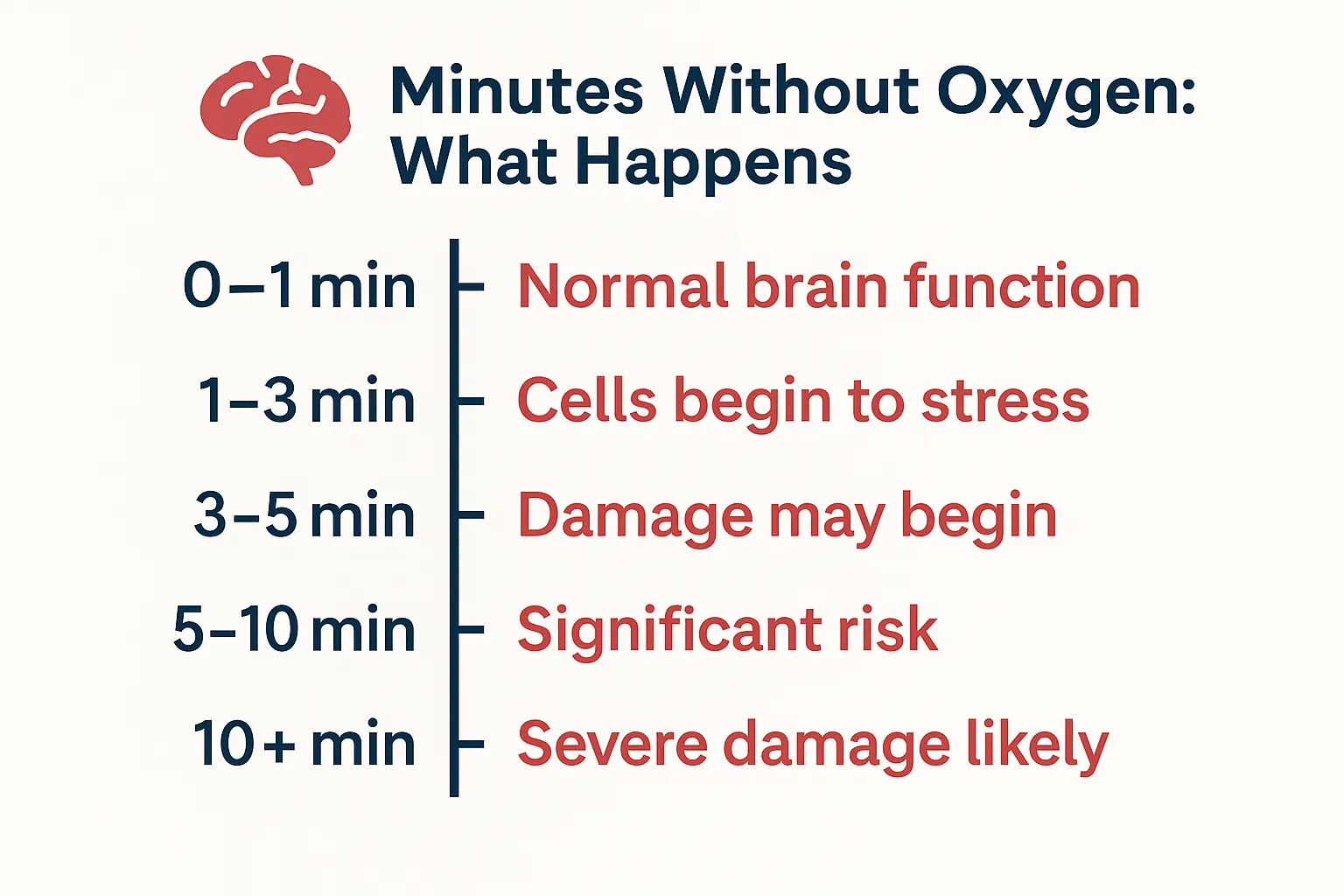Important: This is general information. If someone isn’t breathing or is unresponsive, call 911 now and begin CPR if you’re trained. Every minute without oxygen threatens the brain. Brain cells begin dying within minutes when blood flow or oxygen stops.
Table of Contents
The short, straight answer
People ask: “How long does it take to get brain damage from lack of oxygen?” and “How long can the brain go without oxygen before damage?” There isn’t a single clock for every person, but the risk ramps up fast:
- Within minutes, neurons begin to die if oxygen does not reach the brain.
- Around ~5 minutes, the chance of serious, potentially irreversible injury becomes high in typical, room temperature conditions. (Cold water drownings are outliers.)
That’s why bystanders matter: immediate CPR circulates some oxygen and can delay brain injury while you wait for an AED or EMS. The American Heart Association notes that survival is threatened for every minute CPR is delayed, start chest compressions now if a person is unresponsive and not breathing normally.
A simple timeline you can remember
| Time without oxygen | What’s happening (typical adult, normal temperature) |
|---|---|
| 0 to 1 minute | Loss of consciousness can occur quickly when blood flow to the brain drops (e.g., cardiac arrest, choking). NINDS |
| ~1 to 3 minutes | Cells are stressed; injury risk begins if oxygen isn’t restored. |
| ~3 to 5 minutes | Brain cells begin to die; damage risk rises sharply. Wikipedia |
| ~5 to 10 minutes | High risk of severe, often irreversible injury without circulation/oxygen. (Rare exceptions: profound hypothermia.) Wikipedia |
What to do right now (if this is an emergency)
If you’re with someone who collapses or isn’t breathing normally, don’t wait to see “how long you have.”
Call 911. Put the phone on speaker.
Start hands only CPR: push hard and fast in the center of the chest until help arrives or an AED is ready. Early CPR helps deliver limited oxygen to the brain and buys time.
Use an AED as soon as it’s available; follow its voice prompts. Shocks for treatable rhythms plus continuous CPR give the best chance of survival and better neurologic outcomes.
Why timing matters so much
The brain is the body’s biggest oxygen consumer per gram of tissue. When the heart stops or breathing fails, oxygen delivery ceases and energy stores fall fast. The AHA emphasizes that brain cells start dying within minutes without oxygen, which is why “time to CPR/AED” is the strongest variable a bystander can control.
Clear answers to common queries (worked into your keywords)
If you’re asking “how long can you go without oxygen before brain damage?“, the honest, usable answer is minutes, not hours. Action in the first minutes (CPR + AED) changes outcomes.
If you’re wondering “brain cells begin to die after how many minutes of no oxygen?”, many references place this at a few minutes, often around five in normal conditions, with risk increasing every minute care is delayed.
If you need “how long does it take to get brain damage from lack of oxygen?”, assume immediate danger and treat it as an emergency. Waiting to hit a precise minute mark is the mistake that hurts outcomes.
When outcomes can be better than expected
There are rare scenarios, especially rapid hypothermia (certain cold water submersions), where cooling slows brain metabolism and extends the window for recovery. But these are edge cases and require expert post resuscitation care; they don’t change the rule that minutes matter for everyone else.
Not medical advice. If someone is unresponsive or not breathing normally, call 911 and begin CPR now.




